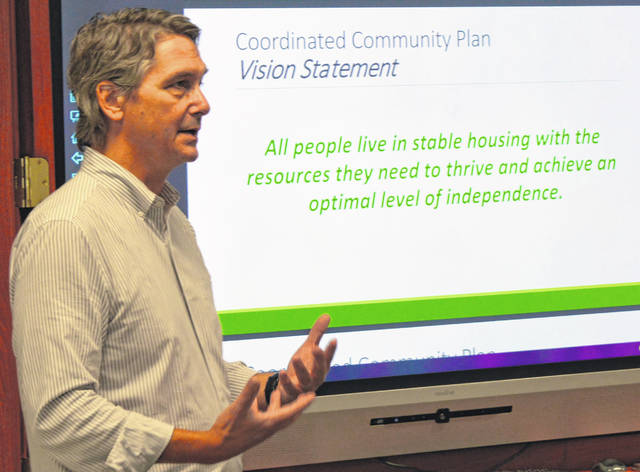
WILMINGTON — Consultant Tom Albanese told the Clinton County Coalition on Homelessness he wants to bring into the conversation people experiencing homelessness or who are borderline sheltered.
So at the coalition’s most recent meeting, he related the stories of “Jane” and “Pete”, not their real names, who were interviewed in the process of creating a local Coordinated Community Plan to Prevent & End Homelessness.
There are some campgrounds in Clinton County where people may reside in RVs or trailers not meant for permanent habitation, and lack either electric or water much of the time, regarded as basic for a sheltered person. Jane is one of them.
She lives in a trailer with a tarp on top of it, and doesn’t have utilities half the year, said Albanese.
“Jane previously had a house and car but started drinking and then, she said, “everything fell apart.” In 2020, Jane bought a trailer for $1,200. The roof now leaks and there are rodents. Her prior two boyfriends were abusive, causing Children’s Services to get involved. Jane had an alcohol relapse but has been clean for over a year and her boyfriend is gone.
“However, in February, her two children were removed after Jane was told her trailer was too small and inadequate. Since then, Jane has missed some visitations with her children because there’s no reliable cell or internet service and she has no car or other transportation,” according to Albanese’s PowerPoint summary.
“She was very distraught, I should say that again,” he told the coalition.
Jane is on Medicaid, and likely meets state and federal qualifications for various other types of assistance, said Albanese.
“In other words, there’s more that Jane can access if she knew how to access it, and she had the help to do so,” he said.
With the right coordinated housing and service supports, Jane and her family’s barriers to housing and greater independence are solvable, said Albanese.
“This is not an insurmountable problem,” he stated.
It will, though, require intervention from the community, he thinks.
The second local story is about Pete.
“Pete is a young a man and had been staying with his Dad but “got kicked out” when he turned 18. He went to stay with his aunt for 6-7 months, but extremely poor (“nasty”) living conditions (cockroaches, etc.) and a dispute caused him to leave. Pete then spent the last 4 years staying on and off with his Dad, his aunt and various friends, all the while struggling with major depression and suicidal thoughts.
“This past spring Pete went to a treatment facility for a few days before coming to the Clinton County Homeless Shelter as he had nowhere else to stay. Pete says he has food stamps and tried to get SSI a few years ago but was told he “would have to wait 2 years.” He has a broken hand and “messed up” shoulder. His case manager from Talbert House is helping him apply for housing, though he was told that it would be hard for him since he has no income.
“Pete is willing to work as he is able and said he “just wants a stable place to live”, have someone help him find a landlord and be a source of support,” concludes the PowerPoint recap.
Albanese’s observations and comments on Pete include that Pete is receiving mental health case management support and help from the Clinton County Homeless Shelter, and that he likely qualifies for additional vocational rehab, workforce, healthcare, and SSI supports.
Similar to what Albanese said about Jane, he says that “with the right coordinated housing and service supports, Pete can obtain stable housing and employment, improve his mental and physical well-being, and increase his independence.”


